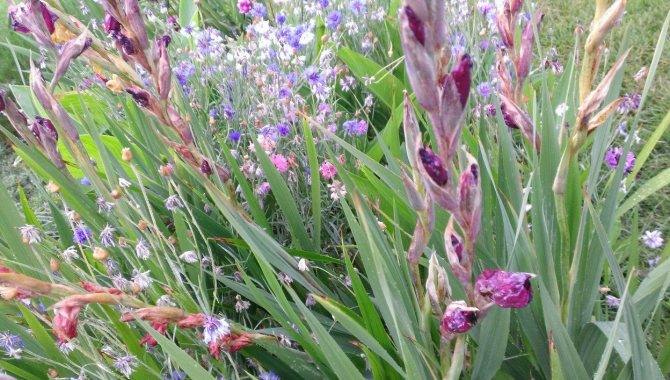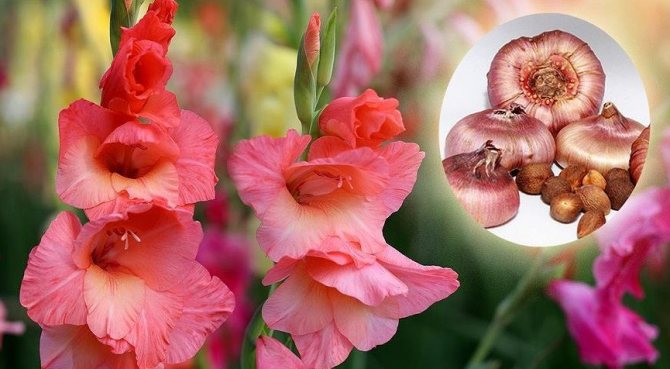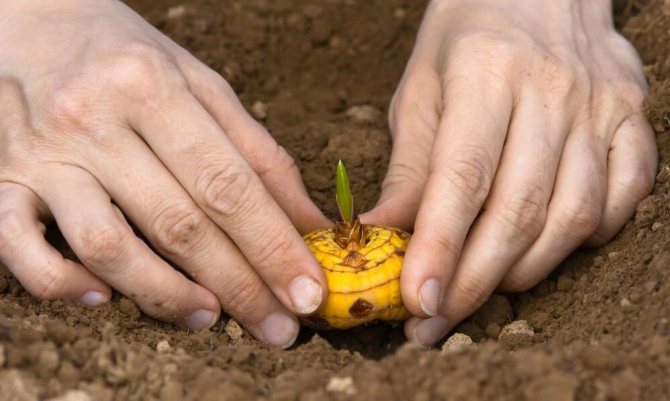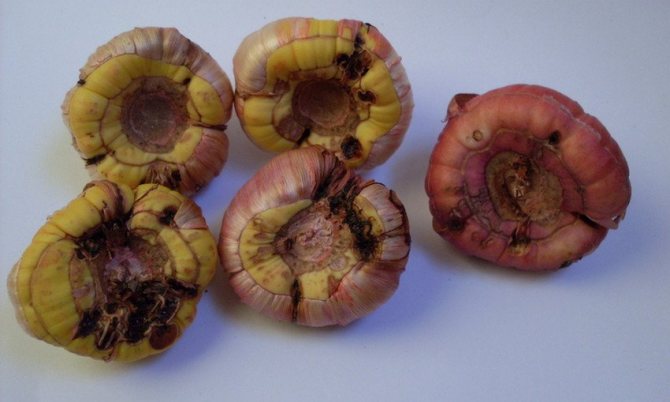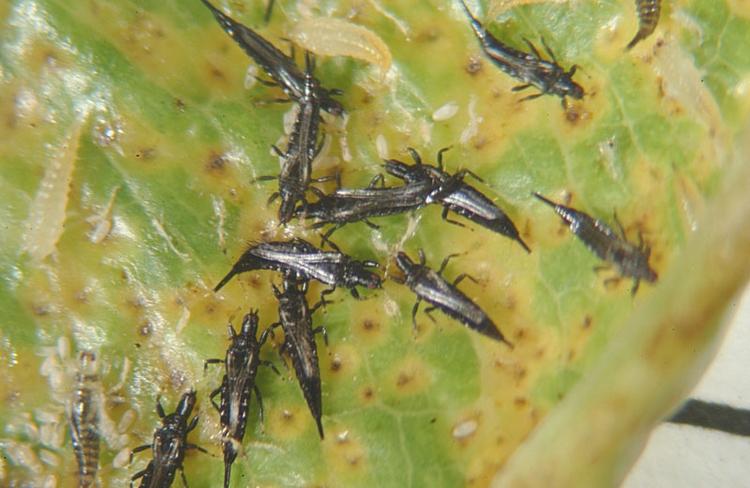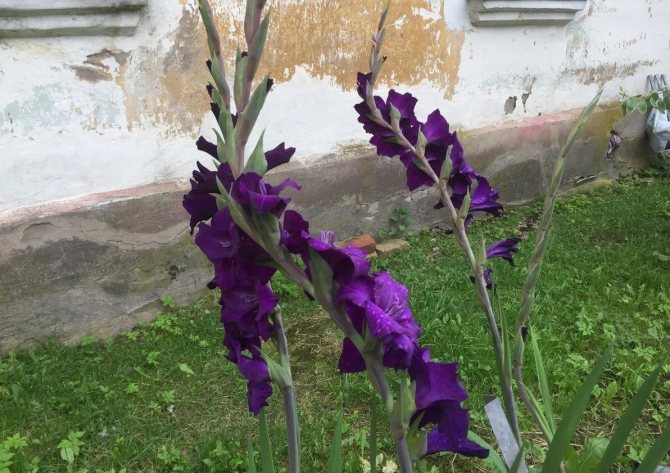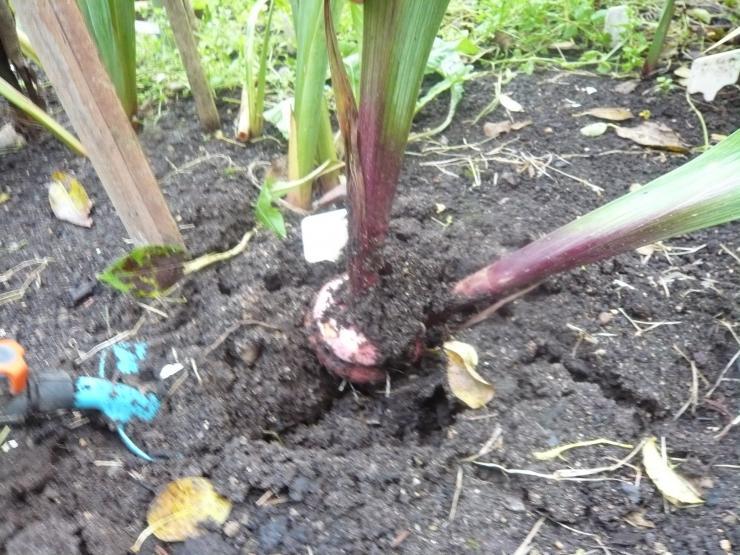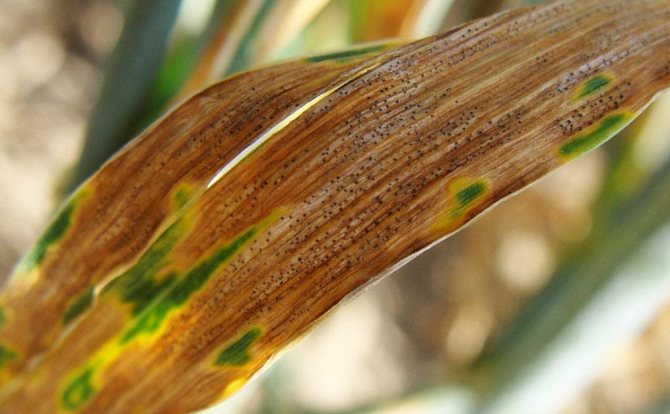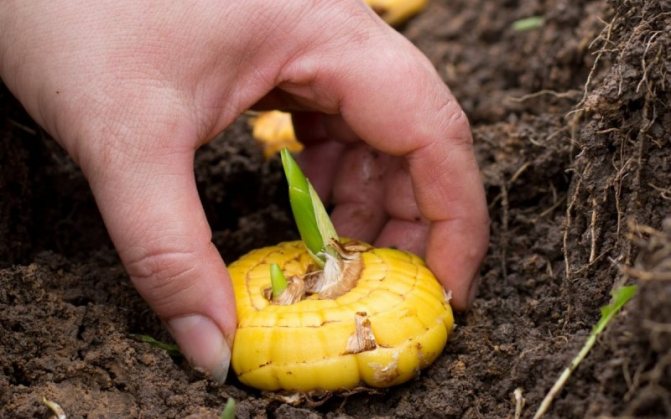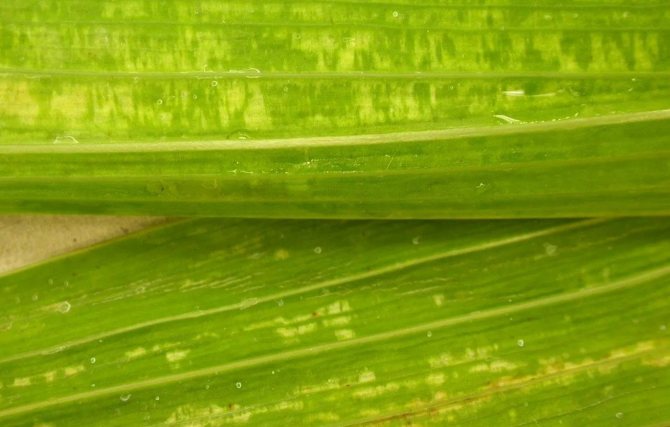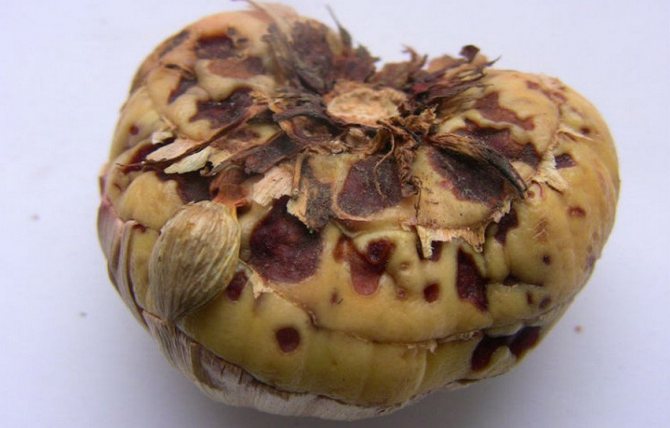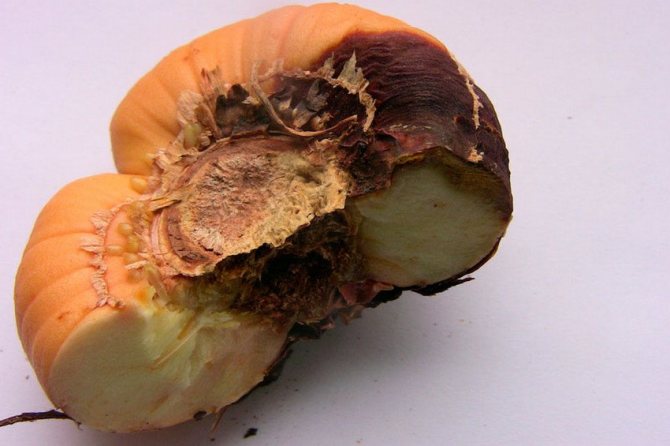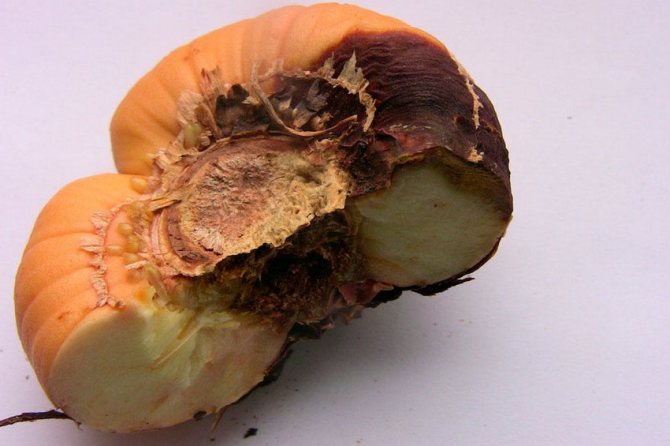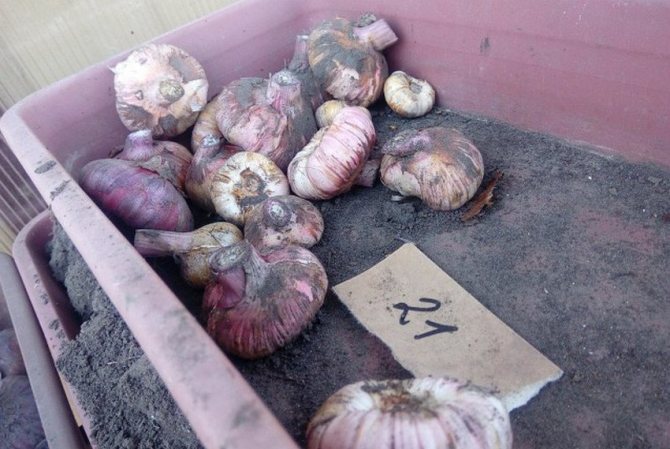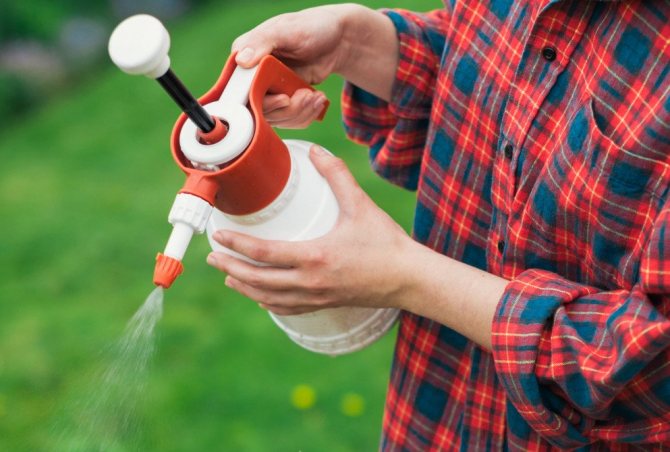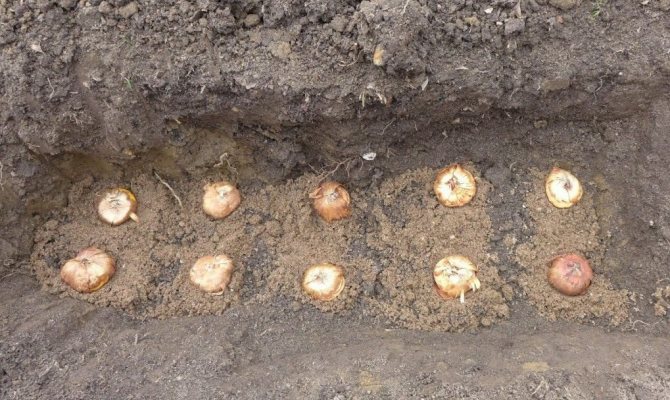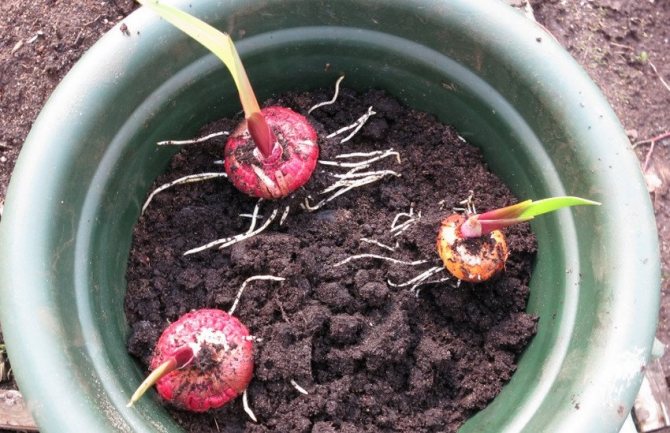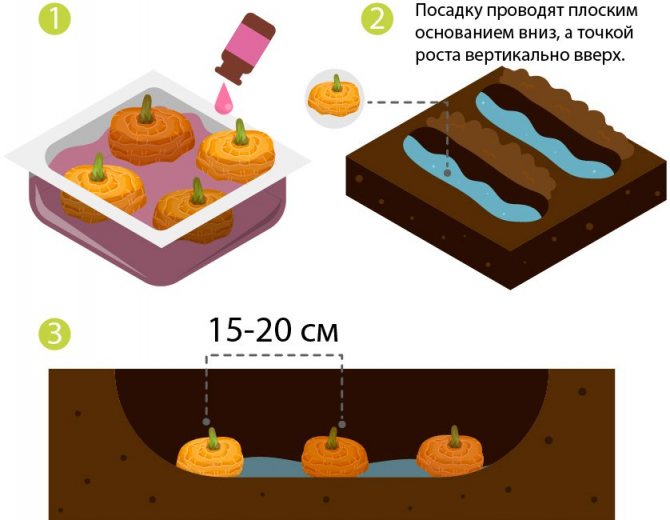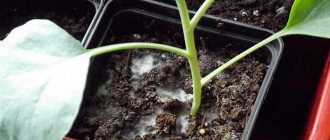Gladiolus (also called a skewer) is a perennial bulbous flowering plant of the Iris family. Translated gladius means "sword". The flower was named so because of the external resemblance of the stem to a sword or sword.
In total, there are more than 200 species of gladioli, and breeders have already bred more than 5,000 varieties. These flowers are simply adorable. They are suitable for decorating gardens, flower beds and for cutting into bouquets. But sometimes things go wrong. Flowers do not form an arrow or change the shape of peduncles and leaves. And many novice flower growers ask the question why gladioli do not bloom, what to do and can they be made to bloom? And today's article is about these flowers, what to do if gladioli grow poorly: how to feed, how to cure.
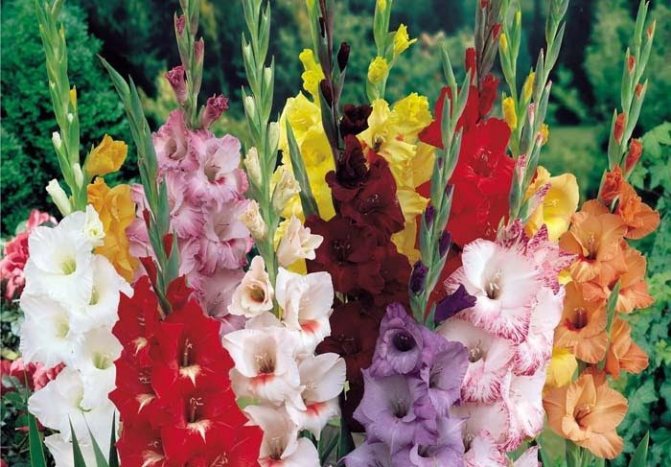
Gladioli
Why gladiolus does not bloom
You have planted gladiolus bulbs, and you hope to get lush, beautiful flowers, and now a lot of leaves grow from the bulbs, but there is no question of flowers - there are no peduncles or flowers. What is the reason?
- Gladioli do not bloom for various reasons, one of them is low-quality bulbs, or planting material. Sometimes in flower shops small or old bulbs are not expensively sold - they either have not yet gained the strength necessary for flowering, or have already exhausted their resources and are unlikely to ever bloom at all.
- Young and mature bulbs should not be planted together. Adults and mature people have more strength, they will grow faster on the site, and they will begin to oppress the young. The bulbs should be sorted and planted in different areas.
- For gladioli to bloom, you need to plant them at the correct depth. On light soil, it should be equal to four diameters of the bulb, on heavy soil, three diameters.
- The soil temperature during planting should be at least +7 degrees.
- Among the variety of varieties, and there are really a lot of them and it is not so easy to make the right choice, find those that are designed specifically for your climate, that is, adapted, acclimatized varieties. So, late or medium varieties simply do not have time to gain strength and bloom in a short and cold summer.
- Now, basically, they offer the bulbs of Dutch gladioli, they are liked by flower growers, but not everyone knows that some of these varieties do not bloom every year. So, they can bloom magnificently once every 2-3 years, and the rest of the time they can rest and accumulate strength for future flowering.
- It is important to find the right place for gladioli. These are not the most capricious and demanding plants, however, they love light, and if you plant them in the shade, you can not wait for flowering. In a shaded place, flowers of all varieties form flower stalks a little later than in the sun. Flowers feel bad even with a lack of fresh air, in such conditions they are attacked by fungal diseases, if all the power of the plant goes to fight this problem, there may not be flowers.
- You should not plant gladioli in the same place every year. Each plant chooses from the soil those substances that it needs. Crop rotation is a prerequisite for all plants, including gladioli.
- Improper watering is another reason for the lack of flowering. In a dry, hot climate, gladioli need to be watered every day in large portions; in other regions, watering is carried out depending on weather conditions.
- To retain moisture, the soil near the flowers is mulched.
- A rainy, cold summer can also cause "no bloom" - it is difficult to give the right advice here.
- Insufficient care - the soil around the flowers must be loosened after each watering so that the roots receive the oxygen they need and breathe.
- Poor soil and lack of fertilizers - this problem is easily solved by applying top dressing. Gladioli respond well to foliar feeding, they assimilate it even better. The first time the flowers are fed with urea and potassium, when they have 3 true leaves. After the growth of four leaves, a second feeding is carried out with the same fertilizers. Foliar dressing is carried out between root, potassium permanganate or boric acid, which, moreover, serve as a good protection against pests. Foliar dressing can be carried out 3 times per season.
- Incorrect cut. When cutting flowers on a bush, leave four to five leaves so that the bulbs receive all the nutrients they need for the next season.
- Exhaustion by "babies" is another reason why gladioli refuse to bloom. Sometimes too small “babies” of bulbs begin to bloom, about one and a half centimeters in diameter. Peduncles should be removed so as not to deplete either the shoot or the "mother" bulb.
- A bulb tainted by a wireworm is unlikely to have the strength to bloom. To protect the bulb from this and other pests, you need to add the "Protection" agent (1 tablespoon) to the hole.
- Thrips - insects settle in buds and eat them from the inside, sucking out juices. Flowers begin to fade, turn yellow, and then fall off. There is also a remedy for thrips - this is Actellik or Aktara. Over the summer, flowers are sprayed with them 3-4 times. The ambassadors of digging out the bulbs are soaked for prophylaxis in a solution of Karbofos for 10 minutes, and then washed and dried.
Lack of proper care


All plants need care and attention. Only some of the reasons why the flowers will not gain strength, which means they will not bloom:
- Insufficient amount of nutrients in the soil selected for planting. On light soils, the bait should be root and foliar, then it is better absorbed.
- Gladioli require aeration of the soil. After watering, the soil around the plant should be well loosened. If insufficiently strong seed was planted, without this procedure it will not bloom.
- The first time the flowers are fed with urea and potassium, when they have 3 adult leaves. In the phase of 4 leaves, a second feeding is carried out with the same fertilizers.
For top dressing, it is better to use water-soluble forms: it is better to do the first 3 procedures with nitrogen fertilizers (they are better absorbed), the subsequent ones - with phosphorus-potassium fertilizers without chlorine.
For better growth, it is worth mulching the soil. What is it for:
- Retains moisture in the soil.
- Controls the temperature balance of the soil. The root system is protected from overheating or hypothermia.
- During watering or rain, nutrients will not be washed out of the soil.
- The soil does not dry out and does not become covered with a hard crust.
- Mulch prevents weeds from breaking through, which will clog flowers.
Flowering is affected by the correct cut. When cutting flowered flowers, leave at least 4 leaves on the plant. Otherwise, there will be an outflow of nutrients. The replacement corm will be weak.
It is bad if young gladioli bloom too early. If a plant has bloomed, barely reaching a diameter of 1.5 cm, its further growth will be inhibited and the flower may not bloom next year. In this case, it is worth cutting off the emerging flower buds. Peduncles should be removed so as not to deplete either the shoot or the "mother" bulb.
The bulbs should be dug out after the first severe frosts. Usually this is the end of September - beginning of October.
How to make gladioli bloom in a flower bed: 6 common mistakes
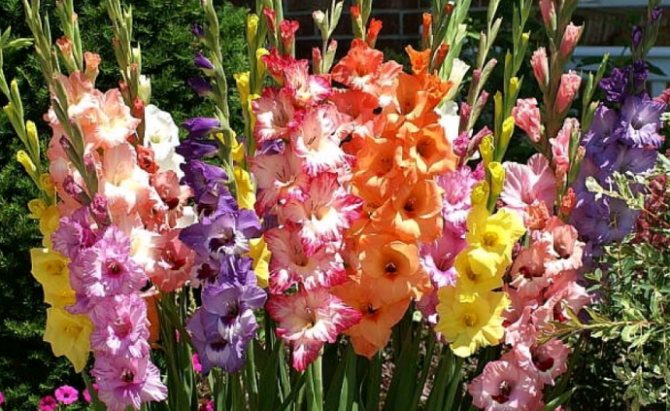

Growing flowers in your backyard is not difficult. But sometimes they don't bud. Gladioli are no exception. It would seem that nothing ordinary happens, but the plants refuse to please with lush flowering at the right time.
In my flower beds, such troubles also happened. To figure out why gladioli do not bloom, I had to re-read books on floriculture and communicate with professionals on this topic. Now I can share the acquired experience and knowledge.
The fact is that there are several situations that affect the flowering process of gladioli. In each of them, you have to take advisory measures.
Probably many will confirm my words that it is not worth planting substandard material. Weak and small bulbs will not produce a strong green mass and may not produce flowers.
But keep in mind that even expensive Dutch bulbs may not flower in the second or third year, despite the fact that after the first planting they were with flowers. This can happen due to their adaptation to local climate conditions.
Do gladioli get pollinated?
It is believed that gladioli are not able to get dusty. Why? Because they are propagated by seeds only by breeders in order to obtain new varieties.
And when multiplying by bulbs, the characteristics of the mother flower are fully transferred to the cub.
Of different varieties
Pollination does not threaten gladioli in private gardens, but they are still recommended to be planted according to varieties, in groups. They do this in order not to confuse the bulbs during storage and dig them out separately. After all, subsequently only the best and healthiest planting material will be selected, the rest will go to waste. As a result of such actions, only a couple of the most hardy and strong varieties remain in the garden. As a rule, they have low decorative qualities. The owner, on the other hand, has the impression that the flowers have become dusty and all of the same color.
Growing beside
When several varieties of gladioli are planted nearby, they must be cross-pollinated. But in order to observe the result obtained, you must first collect seeds from a flower, then grow corms from them, and only then they will delight the owner with a new unexpected riot of colors. This is a long and laborious process, which is why most gardeners propagate gladioli by separating the bulbous babies. With this method, no cross-pollination of flowers is scary, even if many varieties with different characteristics are grown nearby.
Gladioli are beautiful and majestic plants. Their color scheme is simply amazing. So that they please the eye of the owner for a long period of time and do not change the withered varietal characteristics, the plants must be properly looked after, prevented from diseases and pests, and made sure that the bulbs of cultivated varieties do not mix with each other during storage. Do not worry that your favorite flower will be pollinated from other gladioli if the gardener does not use the seed method of propagation and is not fond of selection.
Planting place
I noticed that gladioli sometimes do not bloom due to the wrong place for the planted flower bed. It has a bad effect on flowering if they are grown in the same place all the time. It is advisable to change the planting site for the third year. Otherwise, they will not only not bloom, but will also start to hurt.
If a flowerbed with flowers is placed in the shady part of the site, then during the mild summer gladioli simply will not have time to form a peduncle. This usually happens if gladioli of late varieties and with an average flowering period are planted in a shady area.
It is even worse if the area is not sufficiently ventilated. This causes fungal diseases, which ultimately also affect the process of flower formation.
Are gladioli of different varieties growing nearby are pollinated
When gladioli of different varieties are planted close to each other, their cross-pollination can occur. However, in order to subsequently contemplate the result of such a cross-pollination, one should:
- collect seed from a flower;
- grow a young new corm from the collected seed;
- wait for the bulb to sprout and delight you with its unusual flowering, characterized by a riot of colors and shades.
As practice shows, summer residents do not engage in the above-described agrotechnical measures due to the duration and laboriousness of the process. Most flower growers prefer to breed skewers by separating bulbous babies from the mother material. This method avoids cross-pollination, even if there are different varieties of gladioli growing nearby.
Incorrect planting of bulbs
When planting bulbs, you should adhere to the following rules:
- if the future flowerbed has light soil, then the bulbs need to be deepened into the soil by about 4 bulb diameters;
- when planting on heavy soils, it is necessary to deepen to a shallower depth, about 3 of their diameters.
Do you sort the bulbs when you plant? If you plant young bulbs and those that are already several years old on the same flower bed, then the older plants will drown out the growth of young corms. Therefore, those bulbs with a wide bottom are best planted on a separate bed.
Pests
Flowers will not appear if the bulbs affected by the wireworm are planted. The same result will be obtained if the seed is infected with thrips.
Do you know what thrips are? These are very small insects, difficult to see. They are usually found inside the buds. You can determine that plants are affected by thrips by changing the color of the buds. They turn white at first and then turn yellow. Of course, after that, the buds will not open.
In the fall, insects penetrate the scales of the bulbs, feeding on the plant juices during storage in the winter, and by the spring planting the gladioli will already be weakened.
To protect plants from being damaged by these pests, I carry out preventive treatment. There are ready-made preparations: Actellik and Aktara. Even before the appearance of peduncles, I spray them on a flower bed with gladioli. I do this processing twice in a row with an interval between them of 2 weeks. In one season, you can treat the flower bed in this way 3 times, and you should not wait for signs of defeat.
After the bulbs have been dug up in the fall, they must be pickled before storing them. To do this, I first rinse them with plain water, and then fill them with Karbofos solution (you can also use Fufanon). After a few minutes I take them out and dry them thoroughly.
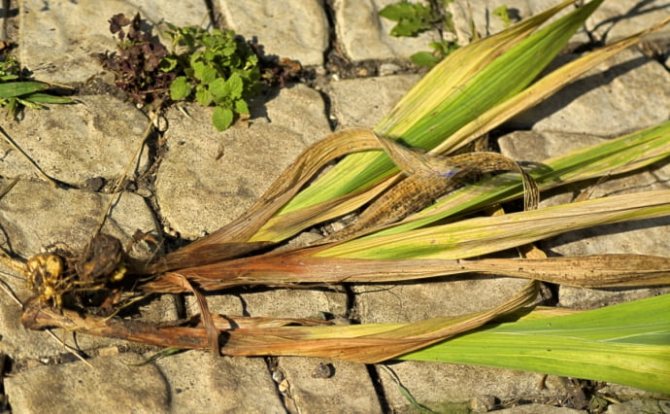

Some growers additionally spray the bulbs with dichlorvos. The bulbs are folded into a plastic bag, sprinkled with a product and tied tightly. After 0.5 hour, they are poured out of the bag and dried in a warm room. I haven’t used this method yet.
Gladioli affected by fusarium practically do not bloom. Although at the beginning of the disease the leaves of plants are green, over time they turn yellow and die. To prevent the disease from spreading to other flowers, diseased plants must be destroyed. A characteristic feature of Fusarium is reddish-brown spots on the bulbs.
Various factors can influence the appearance of fusarium. It can be either dry summer or too rainy. An oversupply of nitrogen fertilizers and too heavy soil also negatively affect.
Do you think that diseased plants can be cured? Don't even try to do it. This is practically impossible. It is better to use preventive measures, and also do not plant gladioli in the same place earlier than 7 years later.
Pests of gladioli
Delphinium (diseases and treatment)
Not only because of disease, flowers look bad.Insect parasites can become the reason for its unimportant appearance:
Thrips
Thrips are very dangerous for gladioli - small brown flying insects, especially their larvae. They settle on the leaves of gladiolus and suck the juices out of them. You can recognize the presence of thrips by the whitish spots on the leaves, which later turn brown. For flowers that have bloomed, the petals look burnt, and unopened buds do not bloom at all.
For prophylaxis, when planting corms, you need to process them in hot water or Aktelik solution.
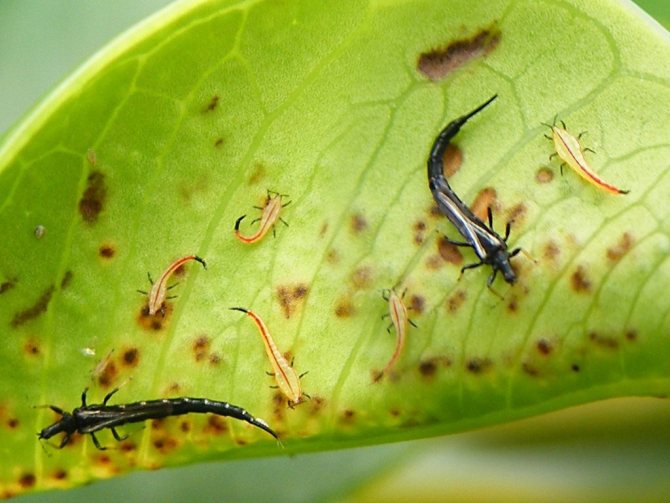

Thrips
After detection already on growing gladioli, it is recommended to spray the plant with a solution of karbofos. After a while, it can be treated with a decis solution. Pest control should be carried out in dry weather.
After the bulbs have been dug up, they also need to be treated with a decis solution.
Important! Experienced flower growers often wonder why they should soak the bulbs in karbofos, when it is much easier to put them in a plastic bag, puff them with dichlorvos and tie them tightly.
Wireworm
These are the larvae of the click beetle. It gnaws at the outer shell of the bulb and eats away at its inner part, in connection with which the plant dies.
It is best to plant gladioli after legumes and garlic, since the wireworm does not like these plants. You can also plant beans or beans in the plantings of gladioli.
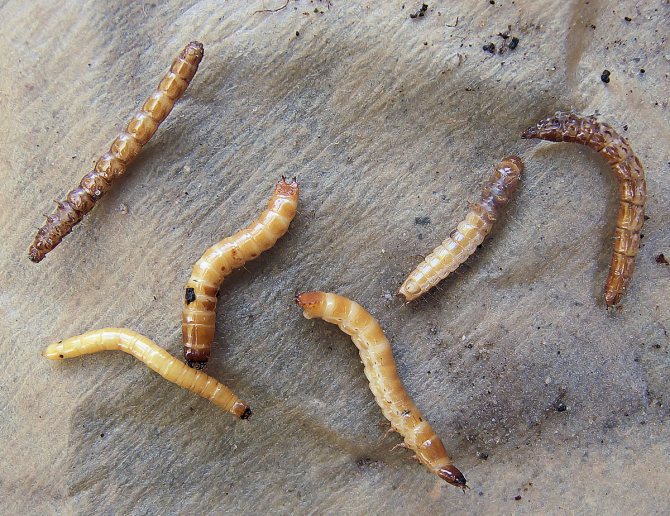

Wireworm
Root onion mite
This pest infects the plant through damage to the bulb. In a diseased flower, the leaves first turn yellow, then they wither, and the bulb becomes rotten. The growing plant is treated with a 10% solution of karbofos, and the dug out bulbs are soaked in a 0.1% solution of karbofos.
How to breed malofos for processing gladioli? The working solution must be prepared immediately before use. It is recommended to take 7-10 g of karbofos powder, dilute in 1 liter of water and mix thoroughly. Using a spray bottle, apply the solution to the leaves and stem of the plant. It is desirable that the solution covers the entire surface. Plants cannot be processed during flowering.
Note! During processing, you must follow the safety rules. After processing, it is recommended to wash your hands well in running water.
Caterpillars and aphids
Leaf-gnawing caterpillars and aphids cause irreparable harm to the landings of gladioli. They gnaw many holes on the leaves, which makes the flowers lose their attractiveness. You can use any of the insecticides to fight the parasites.
May beetle larvae
Gladioli and beetle larvae spoil. They eat up its corms, and the plant dies. Garlic planted between plants repels them well.
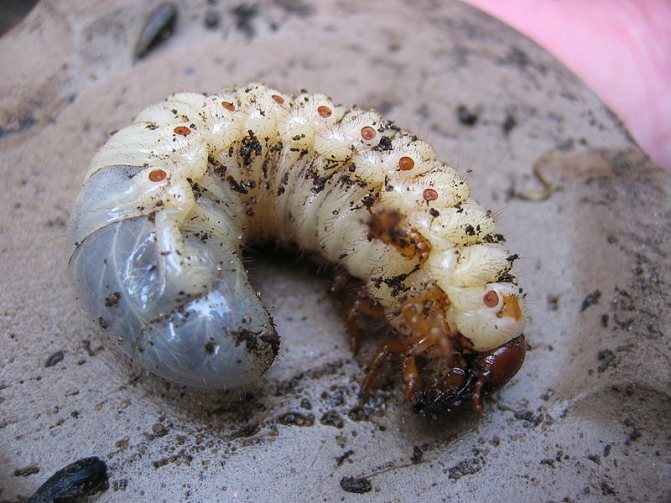

May beetle larvae
Failure to comply with the rules for care
To achieve a friendly flowering of gladioli, you can follow the rules for care. First of all, this is, of course, soil aeration. To do this, the soil must be loosened as it is pressed. Oxygen to the roots promotes flowering. I water so that the soil is soaked to a depth of about 20 cm.
Helps flowering by feeding. Both root and foliar fertilization have a good effect. In order to prevent moisture from evaporating, it is advisable to mulch the soil in the beds.
It is better to carry out the first 3 dressings of gladioli with nitrogen fertilizers, and the next - with phosphorus and potassium fertilizers. I use fertilizers dissolved in water. In no case should fertilizers containing chlorine be applied.
I also recommend that when cutting gladiolus flowers, leave a few leaves on the plant (at least 4 leaves). This condition is required for the normal ripening of corms.
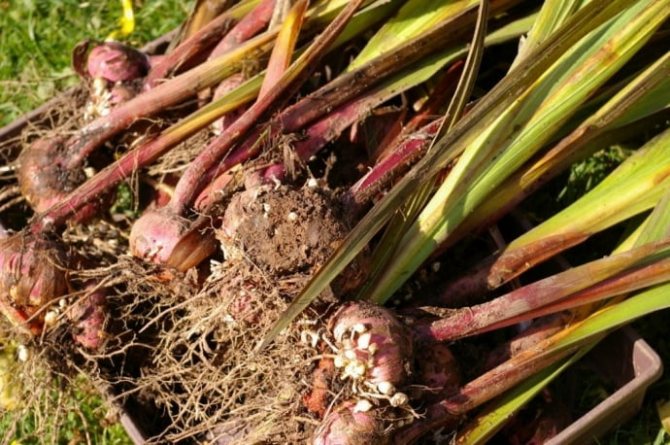

I dig out the tubers after the first frosts begin. This is around the end of September or early October.I store gladiolus tubers in paper bags or in natural fabric bags. It is advisable to ventilate them periodically.
Maybe someone has their own best practices on how to properly grow gladioli so that they bloom for a long time and do not get sick. I would be glad if you share your experience. You can leave your comments at the bottom of the article.
Fusarium
Roots and leaves grow poorly in plants with Fusarium disease. If the disease develops in summer, the leaf plates may remain green for a long time. Later, the whole plant turns yellow and is easily pulled out of the ground. On diseased bulbs, red-brown spots are clearly visible. Affected gladioli should be destroyed.
Excessive moisture or drought, heavy soil, excess organic matter and fresh manure contribute to the development of fusarium. The disease spreads with diseased corms and through contaminated soil.
How to treat?
It is very difficult to cope with fusarium, therefore, in order to prevent the bulb before planting, it is better to soak it in a 0.2% Fundazole solution for 30 minutes. After transplantation, gladioli should be returned to their original place after 7-8 years.
Proper care is the best prevention
Gladioli should be planted in the soil warmed up to 7-10 ° C. To extend flowering, you can plant at different times (until the end of May). In some years, late plantings bloom even better. In a drought, gladioli need abundant watering, moisturizing the soil by 20-25 cm. For top dressing it is better to use water-soluble forms: the first 3 dressings should be based on nitrogen fertilizers, the next - phosphorus-potassium without chlorine. Dug out bulbs after the first severe frost. This is usually late September - early October.
If your gladioli refuse to bloom, consider what exactly you are doing wrong. In the next season, try to correct mistakes, and then the plants will certainly delight you with an abundance of colors.
Why gladioli don't bloom
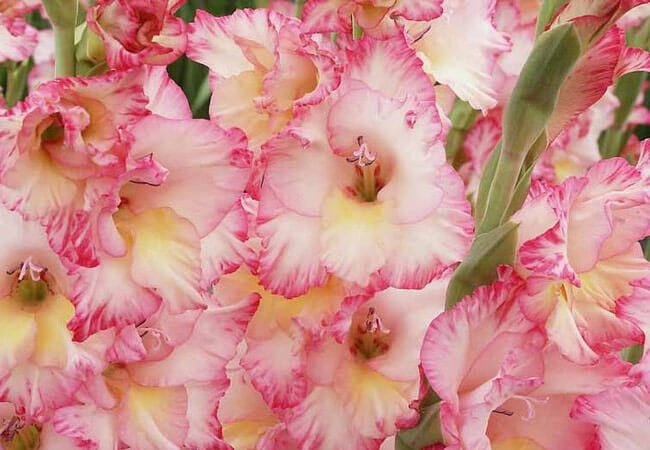

Gladioli (skewers) are tall, stately, flowering plants, around which there are many legends, because their long pointed leaves are like swords. The culture is considered unpretentious, for which gardeners love it, but sometimes problems happen. Here we will consider why gladioli do not bloom or their flowering is very scarce.
There can be several reasons for the poor growth and lack of flowering of gladioli, and everyone who wants to grow these flowers on their site should familiarize themselves with them.
Prerequisites
From where this phrase, "because gladiolus", was found out. But what were the prerequisites for this? On the show “What? Where? When?" there has already been a similar case, some believe that it was he who became the prototype of the same number that was beaten by the Uralskiye Pelmeni team. Then, back in 1992, the team of Valentina Golubeva, now a specialist in the field of public relations, came to the show. And in the third round, a team of experts was asked a question that was estimated at ninety thousand rubles. He touched upon the themes of ancient Rome and touched upon its history, culture and traditions. The question sounded like this: "What was the name of a small sword in ancient Rome, a part of which hung around the neck of a large sword holding a real sword in his hand?"
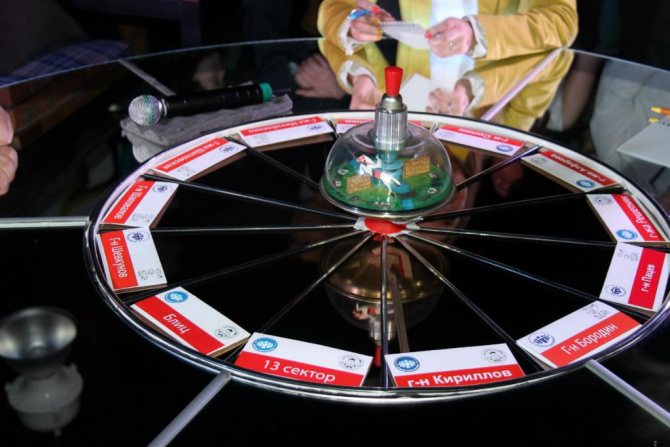

The participants of the show consulted among themselves for a long time, then Vladimir Molchanov began to have an idea regarding the answer to such a tricky question. And since he was most well versed in this topic, he got the right to answer the question. But he was wrong. And to the question: "What was the name of a small sword in ancient Rome, a part of which hung around the neck of a large sword holding a real sword in his hand," the correct answer was the word "gladiolus", which means "small sword" in translation.


When gladioli bloom
The flowering time of the skewer depends on the variety. To date, breeders have bred a large number of species of gladioli that bloom at different periods.
From the moment of planting, the plant blooms:
- very early varieties - after 62-70 days;
- early varieties - for 68-75 days;
- medium early - after 72-80 days;
- medium - 80-87 days;
- medium late - 85-90 days;
- late - after 91-98 days;
- very late - after 100-140 days.
But there are times when gladioli do not tie buds at all or there are very few of them and they are not large. What is the reason for the lack of flowering of the skewer, consider below.
It is also worth considering the adaptation of varieties to your climatic conditions.
Not all gladioli species can grow in cool climates or too hot. There are varieties that bloom magnificently only once every 2-3 years (mostly Dutch).
And here it is no longer a matter of poor planting material or improper care, but of the characteristics of the varieties.
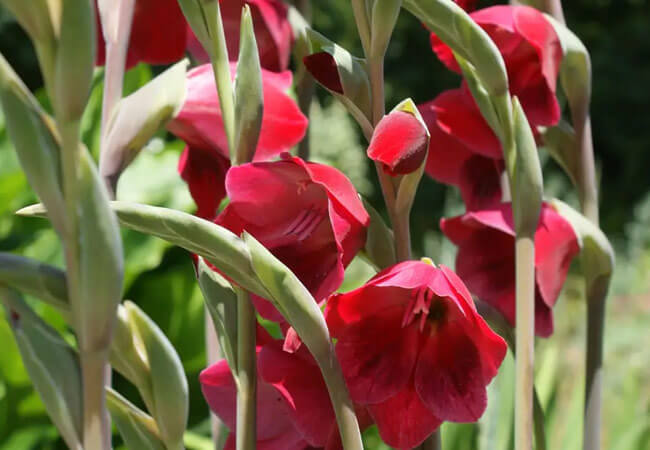

Why gladioli don't bloom
Why gladioli do not bloom - low-quality planting material
A very common reason why gladioli do not bloom is poor-quality bulbs. You can face such a problem if you buy seedlings in a store. Unscrupulous sellers often sell old, small and diseased bulbs to newcomers.
If you collect the material yourself, but it is wrong to store it or you do not make a careful selection of the bulbs, then you can also face the problem of lack of flowering.
The choice of high-quality, healthy bulbs is one of the main criteria in growing a skewer.
The wrong choice of place for growing
The choice of a site for planting gladioli is very important. You need to take care of the necessary conditions long before planting.
- Bulbous plants are not recommended to be planted in the same place for more than 2 years in a row. It is necessary either to completely change the soil in the selected area, or to select a new place for the flower beds.
- Gladioli love sunlight, but do not tolerate the scorching rays of the sun. The place for them should be chosen such that the flowers receive maximum illumination in the morning and evening hours. In constant shade, the culture will grow poorly and may not bloom. Medium and late varieties of gladioli are especially sensitive to light.
- The area where the skewers will grow must be well ventilated. Otherwise, the risk of infection with fungal and bacterial infections increases. But at the same time, there should be no strong drafts in the chosen place. You can not plant the bushes too close to the walls and close to each other, so as not to disrupt the air circulation.
Inappropriate landing site
The planting site also plays an important role in flowering. When choosing a site, it is important to consider all the features. For a flower bed, you should carefully choose a place:
- Gladioli are light-loving plants. In a garden among trees or in the shade of a house, plants will bloom late, and later varieties may not have time to pick up color.
- The place for the flower bed should be changed every 2 years. The earth is gradually depleting and the flowers will lack nutrients. Plants will be weak and will not bloom. Try to plant the flower bed in a different location next season.
- The flower bed for gladioli should be in a ventilated place. Otherwise, the spread of fungal bacteria is possible. Diseased plants will not bloom.
- Flowering can be affected by a lack of moisture, therefore it is better to equip a flower bed in a lowland, where moisture lingers longer in the soil.
Landing errors
Another reason why gladioli do not bloom is the incorrect planting of the bulbs.
Errors can be as follows:
- Bad soil. Gladioli love well-drained soil that is rich in nutrients. They begin to prepare the soil in the fall. It is dug up and fertilized. In the spring, shortly before planting, the soil is loosened again, all weeds are removed, and top dressing is added to it. if this is not done before planting, the bulbs will grow worse, and the lack of elements will lead to a lack of flowering.
- Too much deepening of the bulbs. Her neck with the kidney should always remain out. If the hole is too deep, the soil layer inhibits the growth of the stems, and the bush develops more slowly.
- Planting young and second-year bulbs in the same area... Older bulbs are more robust and can crush young bushes that are still immature.
- Planting in too wet soil or during the rainy season. Bulbs often rot under these conditions.
- Fit too tight.Plants will choke each other if placed in a close row. The distance between the bulbs during planting should be at least 20 cm.
- The soil has not yet been warmed up. If you plant too early in open ground, when the soil has not yet warmed up, the likelihood that the plants will freeze is high. The soil temperature during planting should be at least +8 degrees.
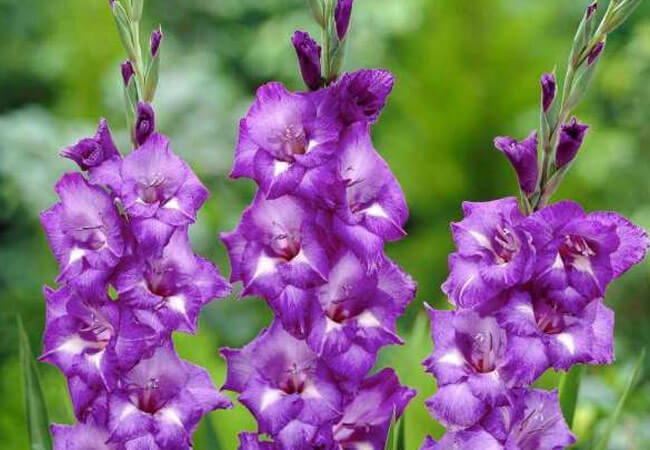

Reasons why gladioli do not bloom
Improper care
Gladioli are not capricious and do not require too much attention. But beginners often violate the growing rules.
Care errors can be as follows:
- Incorrect cropping. When cutting flowers, leave 4-5 leaves on the bush so that the bulbs receive all the nutrients they need for the next season. Otherwise, gladioli may not bloom next year.
- Watering too often. Skaters do not like waterlogging. From stagnant moisture, the roots of the bulbs begin to rot. The soil should dry out by 80% between waterings.
- Rare watering also has a detrimental effect on flowers, especially in hot weather. If the soil is covered with a dry crust, the plant lacks moisture.
- Lack of feeding or improper application. Any cultivated plant needs regular fertilization. Top dressing begins from the moment of planting and nourishes the soil until autumn. When the bulbs are planted and the initial growth phase begins, they need to be fed with nitrogen. From the moment the buds form, flowers need phosphorus and potassium. If nitrogen continues to be added at the flowering stage, the buds may wither without opening.
- Lack of loosening. Lack of oxygen in the soil leads to disease in shrubs. The soil around the flowers must be loosened after each watering so that the roots receive the oxygen they need and breathe well.
Lack of proper care
To get lilies to bloom well, they should be well looked after. Here are a few things you might not be aware of:
Aeration of the soil. After watering, the ground around the gladioli must be loosened. Plants may not bloom without oxygen.
Top dressing... On light soils, it is advisable to apply not only root, but also foliar fertilizers - they are absorbed much better.
Mulching. To retain moisture in the soil, gladioli should be mulched.
Pests and diseases
Diseases and pests are the most common reason why gladioli do not bloom or wither. But not every disease and not every insect can be easily detected on a plant.
- For example, pests such as thrips hide in the buds themselves and feed on their juice.
- Wireworms live in the ground and feed on the sap of roots and bulbs.
- Fungal infections can also stop the development of the bush and, due to illness, it will not bloom.
You cannot completely insure yourself against attacks by harmful insects or infection; there are a number of preventive measures that increase the resistance of the bulbs to such factors.
- Before storage, all bulbs are treated with a solution of Karbofos or Fufanon and dried well.
- The material must be stored in a cool place in compliance with all sanitary standards.
- Before planting in the soil, the bulbs are kept in a solution of potassium permanganate.
- The soil is also treated with antiseptics before planting.
- In order to prevent these insects from settling in the bud, the plant is sprayed with Aktara or Aktellik before flowering during the growing season. The treatment is repeated 2 times a month.
- Shrubs are carefully examined for pests or diseases several times a month. If insects or damage are found, urgent treatment is required.
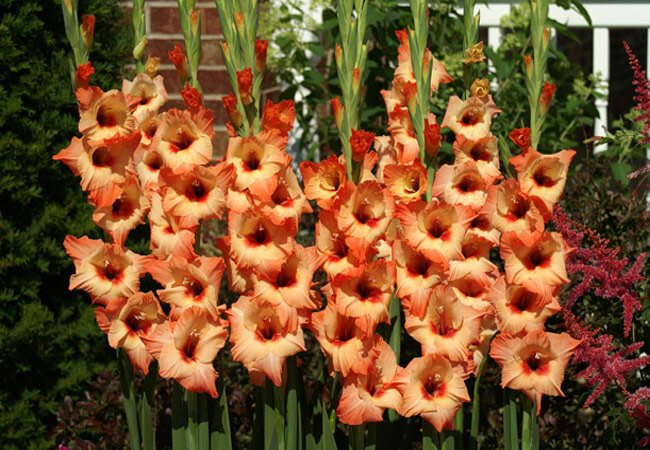

Reasons why gladioli do not bloom
Correct care
Bad weather conditions are often manifested by the lack of flowering in ornamental plants. However, proper care can fix this. If the summer is hot and dry, you need to carefully monitor the soil moisture... Usually watering is carried out once a week, but in conditions of drought and high temperatures, you need to irrigate the soil daily. Water, among other things, will help cool the hot ground. The required amount of water is as much as it moistens the earth to a depth of 30–35 cm.
The procedure required after watering is loosening and cleansing the soil from weeds... For normal development, the roots of any plant need oxygen. Parasitic grasses are dangerous to the culture in that they draw on food and moisture, and also thicken the planting. In dense plantations, there is high humidity and lack of ventilation, and these are ideal conditions for the development of diseases and the dominance of insects.
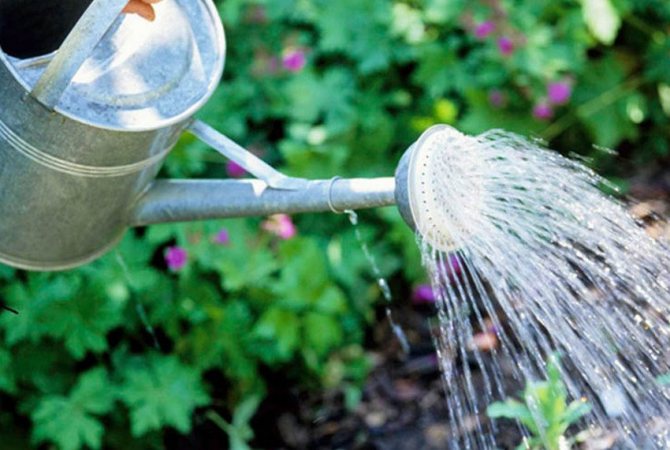

It is important to nourish the soil before flowering. In the spring, nitrogen is needed to set the arrow. You can use solutions:
- urea 25 g per 10 l of water;
- infusion of mullein, diluted 1:20.
When the 6th leaf appears, the culture is fed again by introducing nitrogen fertilizer with the addition of 10 g of potassium nitrate, 20 g of simple superphosphate per 10 liters of water.
To make the flowering lush and long, during the laying of the buds, the culture is fertilized with a mixture of substances (per 10 liters of water):
- potassium nitrate 30 g;
- superphosphate 20 g;
- boric acid 2 g
Important! Fertilizers must be applied in liquid form. Dry formulations are ineffective because they are poorly absorbed.
Correct cutting into a bouquet helps to preserve the ability of bulbs to reproduce. Flowering plants will appear from those "children" who, after cutting the peduncle, were left with 5-6 leaves for full nutrition until they are fully ripe... In addition, the planting material collected for propagation must be properly stored. Bulbs should be immediately sorted out and discarded if damaged by insects or with signs of disease. Keep until planting in a warm, dry place with good ventilation.
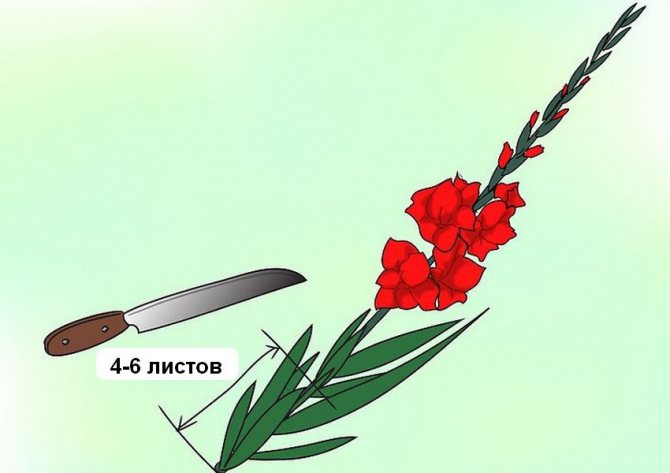

Unfavorable weather conditions
Unfortunately, the weather cannot be predicted or influenced. But sometimes it is the climate that causes poor flowering or its complete absence. Sudden frosts, frequent rains, strong winds - all this negatively affects the development of gladioli. Heat and dryness are also undesirable for bulbous plants.
- In cold and rainy weather, shrubs can be protected with a greenhouse, but the lack of sunlight still cannot be compensated for in an open area.
- If the skewers are exposed to sunburn, it is worth making screens for them.
We have considered all the possible reasons why gladioli do not bloom. To avoid the problem, learn all the rules on how to plant and care for your skewers. If you follow all the growing conditions, then there should be no problems with flowering.
Gladioli do not bloom well. How to make them bloom. Advice
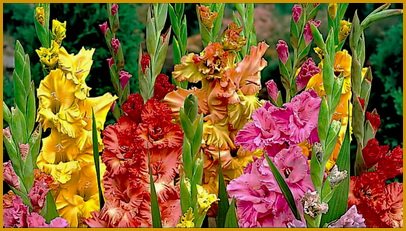

These beautiful tall flowers come to us from Africa and the Mediterranean. Now there are 5000 varieties and every year there are more of them.
From the gladiolus bulb, narrow bluish leaves grow, similar to a blade and reaching 70-150 cm in length.
Its funnel-shaped flowers with six irregular petals are collected in a spike-shaped inflorescence, which can be one-sided, two-sided or spiral.
The flower withers after twelve days and a fruit ripens in its place (a box with seeds). Depending on when gladioli bloom after planting, they are divided into:
- very early - after 65-70 days;
- early - 71-74 days;
- medium early - 75-79 days;
- average - 80-84 days;
- medium late - 85-90 days;
- late - 91-95 days;
- very late - 100-140 days.
However, it happens that gladioli literally refuse to bloom on your site. What could be the reason?
In fact, gladioli may not bloom for a number of reasons, so it will not be possible to immediately answer the question of why bulbs do not bloom in your case.
At the same time, the fact that some of the flowers may not bloom, and most of them may bloom, can add even more mystery to the problem. By the way, this is what usually happens.
Let's try to remember the most common reasons why gladioli may not bloom.
The first problem is poor quality planting material.
The bulbs for planting may have been chosen incorrectly initially - too old or simply weak. At the same time, the bulbs that do not bloom this year can completely improve the next year and bloom after a rest in the current season.
It may also turn out that the bulbs you bought belong to a variety that does not take root well in our climatic conditions.
It even happens that you get beautiful Dutch bulbs and they bloom perfectly for the first year, but the next season or even two years in a row the flower stops blooming, adapting to the conditions of our climate. Therefore, one way or another, such seedlings will bloom, but after a while.
Do not forget about crop rotation - the bulbs will not bloom in the same place for more than three years, so do not be lazy to transplant plants to a new place every 2-3 years.
Can gladioli be pollinated and change color?
Quite often, gardeners are faced with the problem of changing the original color of the gladiolus - in the process of development, flowers grow in the wrong color or shade that was expected. As known, the bulb of the plant is able to retain valuable varietal traits for 4-6 years... Further, she gradually begins to lose the individual characteristics of the variety, change the color of the flower to close to the "wild" varieties. Biologists were able to identify a number of main reasons for this phenomenon, in particular, bacterial and fungal diseases, improper care and storage of bulbs.
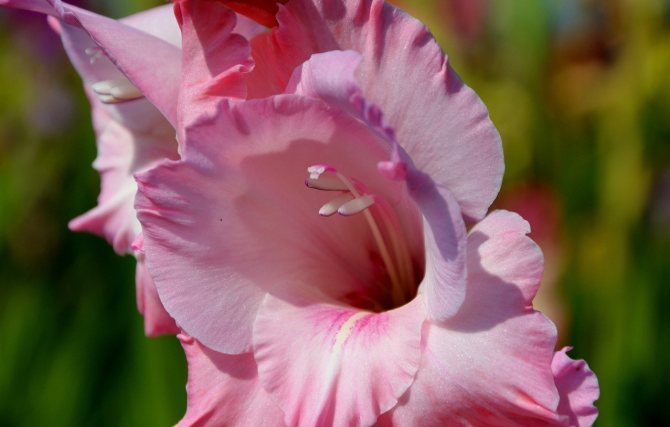

How are they pollinated
Quite often, inexperienced gardeners write off the "degeneration" of gladioli and the change in their bright color to cross-pollination. In fact, the plant cannot be pollinated, provided that bulbs or children were used in the planting process. With the vegetative method of breeding the culture, the children completely retain and repeat the main varietal characteristics of the mother material... In this case, the main reason for the "degeneration" of the skewer and the loss of color in this case is the aging of the bulb.
Important! Re-pollination is possible with the seed method of reproduction, but it is extremely time consuming and is used only by professional breeders to develop new varieties.
For 4-6 years, one corm is able to actively grow, release buds, delight with a rich and exuberant flowering... Further, it begins to age rapidly, which leads to a shrinking of flowers, a change in their color. If after a specified time the bulb is not replaced with a young one, then the flowers on the gladiolus will be few, grow small, of a faded color.
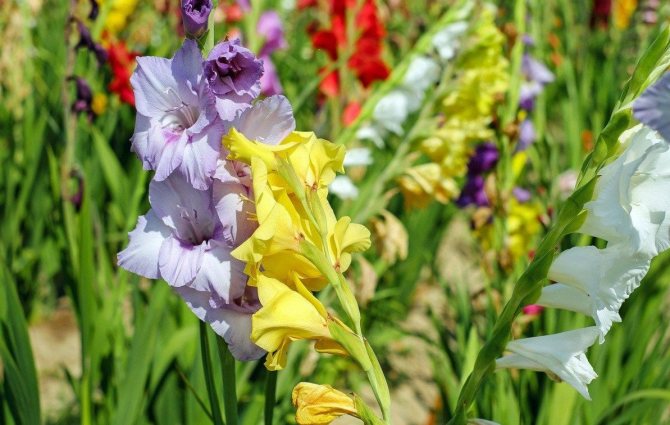

How and why to pollinate gladioli
By themselves, skewers in their natural environment are not able to pollinate, since their pollen matures a little later than the pistil opens. Pollination can occur by means of bees or gusts of winds, but in this case it is difficult to guess which of the flowers "got" under the crossing... That is why those gardeners who have decided to plant a crop with seeds need to learn how to pollinate the plant with their own hands.
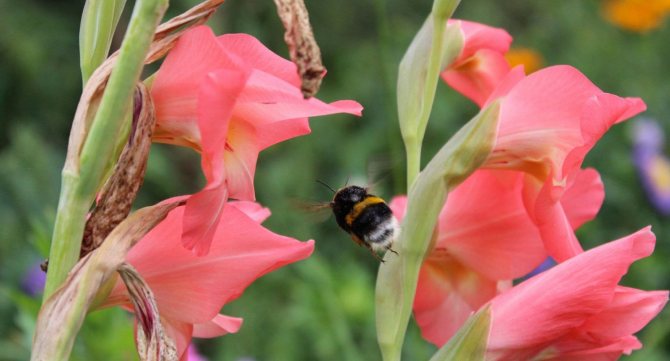

This process consists of the following steps:
- Anthers are separated from male blossoming flowers.
- The cut pieces are lined on a sheet of clean paper and left to ripen.
- When pollen begins to spill out of the dust (which indicates ripening), it is collected.
- Anthers are separated from female flowers.The mother flowers are covered with a piece of breathable material, such as a piece of gauze, and the pistil is expected to unfold.
- After opening the pistil with a brush, pollen obtained from the paternal forms is applied on its stigma, then the flower is again covered with gauze. The tissue is removed when the seed pods are formed in the plant.
After the procedure, a small tag is hung on the skewer, indicating information regarding parental forms... Of course, the pollination process is quite complicated and may not be successful the first time. However, experts advise not to despair and periodically carry out the procedure until the desired result is obtained.
Important! Pollination is not recommended for more than 2
–
3 flowers located on one peduncle. It is advisable to remove excess flowers altogether.
Seeds obtained from seed pods are thin, small plates, no more than 0.2 cm long, which have an embryo in the center... Typically, one box contains 180 to 200 seeds. Store the material in a dry, ventilated, warm place. At too high or low temperatures, as well as high humidity, the seeds quickly lose their germination.



